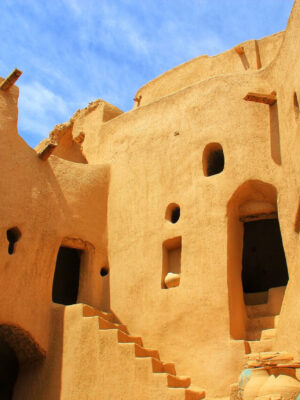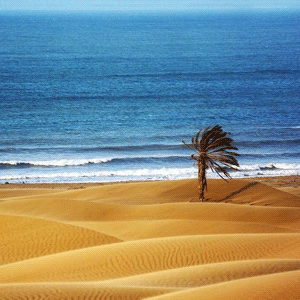The Persian Qanat
The existence of the ancient and still functioning interconnected chains of aqueducts, called qanats, in the heart of Iran’s desert areas is a testament to the innovation and resourcefulness of a people who seemed to have known the true meaning of ‘sustainable development’ thousands of years ago.
Due to the long history of civilizations in Western Asia, there are many theories about the origins of the word aqueduct, or Qanat. Some consider this word to have been derived from “Qano”, with an Akadi’s root meaning reed, which in Assyrian language it become “Qhano”, in Hebrew into “Qana”, and in Aramaic it became “Qanya”. The same word entered the Greek and Latin languages and the words “Qani” and “Qanalis” (canalis) emerged.
The qanat system (underwater channels) is not a simple structure for collecting the miscellaneous water or directing surface water into a canal. It is rather, a very precise and complex technique in which man was able to divert groundwater to his settlements and habitats. By digging holes in the slopes of the mountains, and after digging the mother well, the canal path gradually extends towards the preferred areas, using gravity.

The ancillary facilities of the qanats are even more beautiful than the qanats themselves and in a way represent the architectural art related to the qanat. Reservoirs are one of these facilities, which were created in the heart of the ground with domed roofs and brick materials, calcareous mortar and mortar.
From more than 37,000 qanats which have remained in use across Iran, eleven have been selected by UNESCO as representations of The Persian Qanat. The following chart lists their names and locations:
| Name | Location | Description |
|---|---|---|
| Ghasabeh | Khorassan Razavi | Dates to 3-4 centuries BCE with the deepest Mother Well (200 meters) |
| Baladeh | South Khorassan | The Mother Well runs from Ferdows. It dates back to 1600 CE with 153 wells |
| Zarch | Yazd | It runs for 80 km with 3 branches, and the deepest Mother Well is 90 meters |
| Hassan Abad Moshir | Yazd - Mehriz | Dates back to 1400 CE. Runs for 40 km with 1330 wells and irrigates 10 villages |
| Ebrahim Abad | Central Province - Arak | Runs for 11 km with 311 wells, and dates from 1000-1200 CE. |
| Vazvan | Isfahan - Vazvan | Runs for 1800 m. with 64 wells, dates from 1200 CE. |
| Mozd Abad | Isfahan - Meymeh | Runs for 18 km with 615 wells, dates from 600 CE. |
| Moon | Isfahan – Ardestan | 2 level Qanat runs for 3 km with 30 wells, dates from 578 CE. |
| Gowharriz | Kerman – Jupar | Runs for 3560 meters, dates from 600 CE. |
| Ghasem Abad | Kerman – Bam | Runs for 9840 meters, 100 years old, located within Bam UNESCO site |
| Akbar Abad | Kerman – Bam | Runs for 4811 meters, with 33 wells, 100 years old |
The Persian Qanat
The existence of the ancient and still functioning interconnected chains of aqueducts, called qanats, in the heart of Iran’s desert areas is a testament to the innovation and resourcefulness of a people who seemed to have known the true meaning of ‘sustainable development’ thousands of years ago.
Due to the long history of civilizations in Western Asia, there are many theories about the origins of the word aqueduct, or Qanat. Some consider this word to have been derived from “Qano”, with an Akadi’s root meaning reed, which in Assyrian language it become “Qhano”, in Hebrew into “Qana”, and in Aramaic it became “Qanya”. The same word entered the Greek and Latin languages and the words “Qani” and “Qanalis” (canalis) emerged.
The qanat system (underwater channels) is not a simple structure for collecting the miscellaneous water or directing surface water into a canal. It is rather, a very precise and complex technique in which man was able to divert groundwater to his settlements and habitats. By digging holes in the slopes of the mountains, and after digging the mother well, the canal path gradually extends towards the preferred areas, using gravity.

The ancillary facilities of the qanats are even more beautiful than the qanats themselves and in a way represent the architectural art related to the qanat. Reservoirs are one of these facilities, which were created in the heart of the ground with domed roofs and brick materials, calcareous mortar and mortar.
From more than 37,000 qanats which have remained in use across Iran, eleven have been selected by UNESCO as representations of The Persian Qanat. The following chart lists their names and locations:
| Name | Location | Description |
|---|---|---|
| Ghasabeh | Khorassan Razavi | Dates to 3-4 centuries BCE with the deepest Mother Well (200 meters) |
| Baladeh | South Khorassan | The Mother Well runs from Ferdows. It dates back to 1600 CE with 153 wells |
| Zarch | Yazd | It runs for 80 km with 3 branches, and the deepest Mother Well is 90 meters |
| Hassan Abad Moshir | Yazd - Mehriz | Dates back to 1400 CE. Runs for 40 km with 1330 wells and irrigates 10 villages |
| Ebrahim Abad | Central Province - Arak | Runs for 11 km with 311 wells, and dates from 1000-1200 CE. |
| Vazvan | Isfahan - Vazvan | Runs for 1800 m. with 64 wells, dates from 1200 CE. |
| Mozd Abad | Isfahan - Meymeh | Runs for 18 km with 615 wells, dates from 600 CE. |
| Moon | Isfahan – Ardestan | 2 level Qanat runs for 3 km with 30 wells, dates from 578 CE. |
| Gowharriz | Kerman – Jupar | Runs for 3560 meters, dates from 600 CE. |
| Ghasem Abad | Kerman – Bam | Runs for 9840 meters, 100 years old, located within Bam UNESCO site |
| Akbar Abad | Kerman – Bam | Runs for 4811 meters, with 33 wells, 100 years old |





















